Modern trash causes big issues for wastewater collection systems.
Daily challenges abound for collection system operators and administrators as they work to support the proper operation of their pipes, pumps, controls and related auxiliary system equipment. Continual system stress due to a recent tightening of maintenance and operational budgets has caused the ever-increasing challenge of handling the “modern trash” found in today's new wastewater.
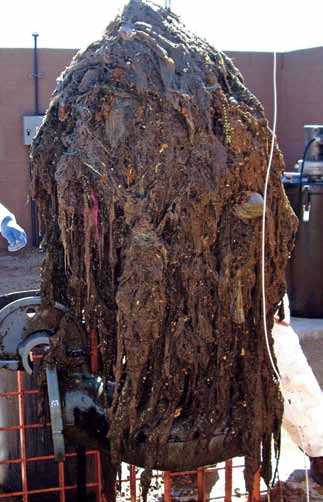
A soft clog mass
What Is Modern Trash?
A huge component to the headaches of today's modern trash are plastics and the synthetic sheet goods—the non-woven material used by manufacturers to act as a carrier for cleaning agents; fabric softeners; and on the softer side, personal care and baby wipes. These thin sheets have become the bane of the collection system.
Of great concern is the impact that these materials have had on collection system pumping operations. These products have been found to partially and fully clog (soft clogging) traditionally designed solids-handling pumps, most of which can attribute their hydraulic designs to work originally conducted by A. Baldwin Wood from about 1917. Wood's work centered on designing a trash handling, multichannel impeller by using impeller vanes with blunt vertical leading edges and a three-inch vane throughlet.
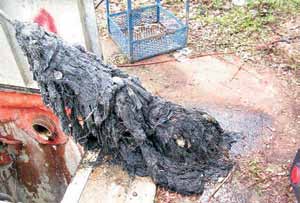
A pump covered with modern trash
Flushability
Front and center to the pump soft clogging issue is the “flushability” of modern trash. Flushability is the term that refers to passage quality of disposable, single-use products often marketed as flushable.
These flushable items may include such products as baby wipes, personal hygiene wipes, single-use floor mop pads, dental floss, single-use toilet cleaning pads, protective undergarments, anti-bacterial surface cleaning wipes and other similar products. In reality, the wastewater industry has found that many of these products are not readily degradable in sewer and septic systems and should not be considered flushable.
INDA, the U.S.-based Association of Nonwoven Fabrics Industry, and ENDA, the European counterpart, have taken the initiative to produce flushability guidelines. This initiative commenced because no consistent or widely accepted definition of what constitutes a flushable nonwoven consumer product existed. The initial report from INDA1 that was three years in the making was released in 2008. INDA describes flushability as the quality that the individual modern trash component possesses that must:
- Pass through the domestic toilet and drainage-line system
- Be transported in a wastewater conveying system
- Be compatible with wastewater treatment systems
The Complications of Modern Trash
The resulting problems with modern trash range from significant damage to equipment, losses in system efficiency, increased operational costs, additional costs for labor/overtime, creating potentially dangerous situations for employees, environmental impacts and time diverted from other needed system maintenance. In most cases, the increased costs associated with addressing the system impacts from these personal convenience products are unbudgeted expenses that divert precious, limited funds from other system needs.
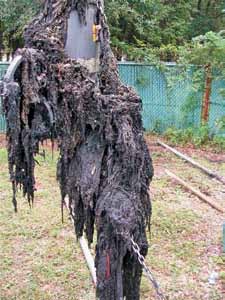
A pump draped with modern trash
Today's modern trash significantly challenges proper operation of the hydraulics of traditional solids-handling pumps. Laboratory testing continues to support field findings that the plastics, non-woven and synthetic sheet materials readily become impinged upon the vertical leading edges of the rotating pump impeller disturbing the hydrodynamic shape of the impeller and lowering its hydraulic efficiency. As additional materials continue to agglomerate with the initial trash, clogging of the pump impeller continues resulting in reduced pump output and ultimately near-complete clogging of the pump impeller.
Concern was first raised in 1993 in a technical paper “Flushability, Transportation and Decomposition of Nonwoven Products”2 when the authors related that flushable nonwoven products may not be flushable in the future. Federal legislation reduced the flush volume for residential plumbing fixtures to 1.6 gallons, effective January 1, 1994. The paper described that laboratory and field studies predicted difficulty in developing consumer products to meet both regulation and the user's needs.
In 2010, a survey developed by the Maine Waste Water Collection Association (MWWCA)3 was sent to its membership to assess the “impact of flushable products” upon their collection system operations. Selected data from that survey includes:
- 87.5 percent report that they have experienced problems due to flushable products.
- 61.4 percent report that they have experienced >10 incidents due to flushable items
- 84.4 percent report clogging problems with small lift/pump stations due to flushables
- 51.1 percent report clogging problems with large lift/pump stations due to flushables
- 59.6 percent report that typical corrective costs due to flushables is up to $1,000 per incident
- 12.8 percent report that typical corrective costs due to flushables of $1,001 to $2,000 per incident
- 88.9 percent of respondents report that their problems with flushables are increasing
Case Study: Moraga Pumping Station
In November, 2010 a report was issued describing the results of a study conducted in June 2010 at the Moraga pumping station located in Moraga in Contra Costa County California. In 2009, the original Moraga pumping station inlet bar screen, with a three-inch bar spacing, was changed to a bar screen having 1.5-inch bar spacing. This resulted in some reduction in pump clogging with an increase in bar-screen cleaning. Pump blockages continued at the rate of once every one to two weeks, which required work stoppage and disassembly of the affected pump to clear the blockage.
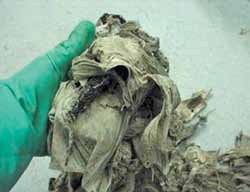
Wet-well debris from a Brewer, Maine, wastewater treatment facility
“Identification of Materials Entering the Moraga Pumping Station”4 executive summary reported that the quantity of materials found at the Moraga pumping station yielded two distinct categories:
1. Bar screen samples were dominated by paper with significant amounts of household cleaning and personal hygiene products. As these material came into contact with the bar screen and overlapped onto one another, forming pancake structures. These formations hindered the rate of flow into the pumps, demanding daily removal procedures.
Paper hand towels comprised 54 percent of the trash caught by the bar screen while 17 percent of the captured waste was made up of personal hygienic products and 13 percent household cleaning wipes.
2. The pump clog sample consisted of stronger nonwoven materials. These long fibrous products, typical of personal hygiene and household cleaning wipes, were twisted and torn into long, knotted rope-like systems. These types of materials were part of the contributing factors leading to the formation of blockages that periodically disabled the pumps at the Moraga pumping station.
Personal hygiene products, wipes and cleaning wipes combined to constitute 89 percent of the pump clogging materials.
Legislation & Testing
On the legislative front, in June 2010, California Assemblyman Jared Huffman brought forth draft Assembly Bill 2256, which would use INDA's guidelines to place into law a consistent definition of flushability and regulation concentrating on packaging for products sold in California. In February 2011, Maine Representative Melissa Walsh Innes (D-Yarmouth) submitted a bill to the Maine legislature (LR 1564) on behalf of the Maine Waste Water Control Association (MWWCA) to address the rapidly growing concern of impacts caused by products advertised as flushable that are not dispersing properly in the wastewater systems.
In summary, “the bill would prohibit the packaging or labeling of consumer products for distribution or sale in the State if the package or label states that the product is flushable or safe for sewer and septic systems unless the product meets flushability standards. The bill directs the Maine Department of Environmental Protection (DEP) to adopt flushability standards.” Maine DEP would be responsible for the review of acceptable criteria for flushability as published by INDA.
The National Sanitary Foundation (NSF) has begun to market an independent validation service to test consumer products as to their flushability and issue a certification for the particular product. The NSF Certification offers validity of the product for use with septic systems and/or for sewer systems. NSF relates that to claim that a product is flushable, the product must generally undergo a toilet bowl and drain-line test, a “dispersability test,” a column settling test and aerobic and anaerobic disintegration tests. These tests encompass the different U.S.- and European-size pathways that a product may follow in the wastewater system.
A Pumping Solution
Recognizing and understanding the increased challenges being experienced by collection system professionals, a new solids-handling pump design was developed. The pump was specifically designed to handle the growing challenges of the new wastewater. A departure from the earlier work of Mr. Wood, this semi-open, back-swept impeller employs horizontally positioned vane leading edges that pass across a groove located in the volute suction cover that promotes trash passage, wiping the impeller leading edge clean. This design has proven to handle the modern trash found in the new wastewater, all the while sustaining high hydraulic efficiency and saving energy.
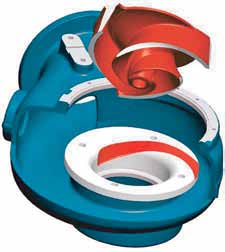
The hydraulics of the new solids-handling pump
Case Study: Andalusia, Ala.
A recent successful retrofit project in Andalusia, Ala., using the new solids-handling pump was completed. At the Central lift station, three 85-horsepower pumps and two 45-horsepower pumps were replaced. At Riverside wastewater treatment plant's (WWTP) influent pump station, three 45-horsepower pumps replaced. The project was funded by a block grant from the U.S. Department of Energy and administrated by the Alabama Department of Economics and Community Affairs.
The project specification required that a minimum 25 percent energy savings be achieved due to the pump retrofit. The documented results revealed energy savings of 56.1 percent at the Riverside WWTP influent pump station, and 48.1 percent was achieved at the Central lift station.5 These savings were directly due to the new pumps' ability to sustain a clean impeller leading edge and prevent their fouling by modern trash. Recently, this pump was chosen by the Water Environment Association to receive its prestigious Collection System Innovative Technology Award for 2011.
The Importance of Education & Labeling
The best solution to minimizing this problem is educating the public regarding the proper use/disposal of these collection system challenges. This requires a combination of the efforts of the product manufacturers to properly label the product packages, INDA and municipalities to inform and instruct end users with regard to the proper disposal of these challenging materials as well as the possible development of carrier sheet materials that can break-down after use within the collection system.
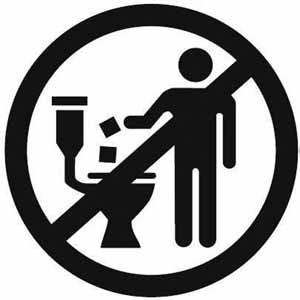
Education and proper labeling is the best solution to the modern trash problem.
Reference:
- “Guidance Document for Assessing the Flushability of Nonwoven Consumer Products” – First Edition – June 2008, INDA.
- “Flushability, Transportation and Decomposition of Nonwoven Products” - T. Konen and C. Christodoulatos - Environment 1993 Conference.
- “2010 MWWCA Survey” courtesy of The MWWCA “Flushables” Working Group: Michelle Clements (Portland Water District), Paul Rodriguez (Woodard & Curran Engineers, MWWCA president), Tom Connolly (Yarmouth, ME WWTF), Gilles St. Pierre (Presque Isle, ME WWTF), Aubrey Strause (Tata & Howard Engineers).
- “Identification of Materials Entering the Moraga Pumping Station” November, 2010 – R. Casey.
- Project Report – City of Andalusia, Ala., “Wastewater Pumping System – Energy Efficiency Upgrade”. GMC No.: A10003, June, 2011, R. Domkowski (ITT Flygt).
Pumps & Systems, October 2011


